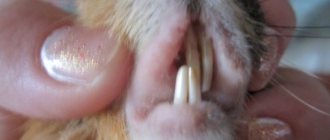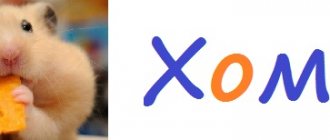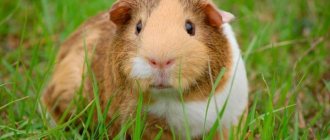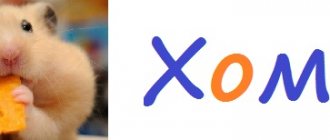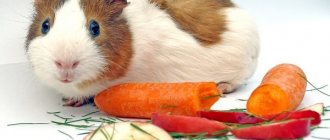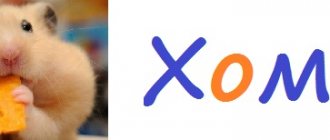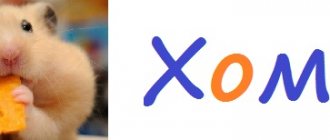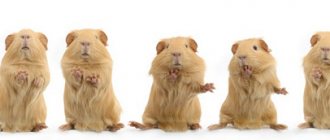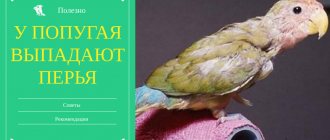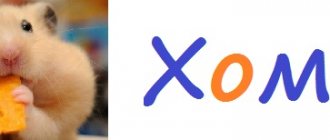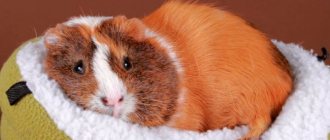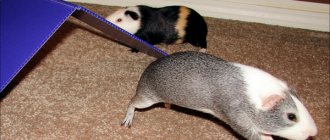- home
- Guinea pig
02/07/2019 For those owners who have recently acquired a pet rodent, it will be unpleasant to find out that their guinea pig eats its own excrement. As shocking as this may sound, it is true. But for experienced lovers of fluffy hamsters, this is far from news. Such occurrences are completely normal behavior for guinea pigs. Don't worry too much. This is a natural phenomenon and scientists have their own explanation for it. The fact is that guinea pigs are coprophages. These are those who, due to the properties and structure of digestion, eat their excrement.
Juicy plant products
The category of such food products includes vegetables and fruits.
The diet should include mainly vegetables; fruit pulp is just a treat for guinea pigs. You should not give your pet too much fruit. Their pulp is saturated with sugars, which in excess are harmful to the body of a small animal. From time to time, the guinea pig is allowed to treat a small amount of cherries, apples, peaches, nectarines, apricots, pears, bananas. The rodent enjoys eating vegetables and berries:
- carrots;
- white and cauliflower;
- zucchini;
- tomatoes;
- bell pepper;
- cucumber;
- corn;
- pumpkin;
- celery;
- seedless grapes;
- green peas.
It is useful to treat the animal once a week with berries rich in ascorbic acid: strawberries, currants, raspberries, wild strawberries. You can also periodically offer the animal leaves and twigs of cherries, blueberries, raspberries, gooseberries, and mint.
Eggplants and green tomatoes should not be included in the diet; these vegetables contain solanine, a toxic compound also present in green potatoes. It is strictly forbidden to give your pet leeks, onions and green onions. Bulb crops are poisonous to rodents.
Many owners are interested in whether it is possible to treat a guinea pig with melon and watermelon. The animal willingly feasts on such a treat and even eats watermelon rinds with pleasure. But you need to keep in mind that melon and watermelon are very sweet products, so you shouldn’t include them often in your diet.
You can diversify your pet's menu with fresh peas, soybeans, lentils, and green beans. It is useful to give your rodent juicy pea pods, rich in vitamins and nutrients.
Other reasons
In some cases, a furry rodent twitches and jumps for completely different reasons. To determine them, the owner should remember events related to the pet that could please him. The animal can rejoice at the received treat or fresh tasty grass. If he has recently been walked outdoors, this may also cause unusual behavior.
It may have to do with the conditions in which the animal is kept. A rodent cannot warm up if it is in a cramped room. He needs more space to play. Due to the lack of active movements, the pet lies on its side and twitches. To change the situation, a caring owner must increase the space by adding toys, wheels and tunnels.
Why do pigs eat their own droppings?
You can often notice how the pig seems to curl up into a ball, pushing its head under its tummy, and then actively chewing something. Don't be scared, guinea pigs are caprophagous - they eat their own droppings. The flora of the pig's cecum produces the enzymes it needs, vitamins B and K, and amino acids that are not synthesized directly in the body or do not come directly from food. As herbivores, when processing incoming food, they are capable of squeezing the maximum out of it, even if this food is not super-vitamin-rich. The pig passes food through the body twice: first, by eating grass/hay and other foods rich in fiber, which are partially digested, while whole colonies of microorganisms work hard in the intestines, which help convert the consumed plant food into the necessary amino acids, and then, eating “night feces” "(underdigested and especially rich in proteins). Therefore, caprophagia, along with incoming food, provides the pig with all the necessary substances and normalizes intestinal function.
Pigs have two types of feces. The first, ordinary one, containing fiber, grass, etc., we see scattered around the cage and shaped in the form of the usual cylinders. And the second, “vitamin”, is formed differently: it is more liquid, and the pig “catches” it directly from the anus, leaning towards it. The inability to eat such feces leads to decreased fiber digestion, increased mineral excretion and weight loss. (Cheeke, 1987; Ebino, 1993)
There is an opinion that if you have digestive problems, you need to drink feces from a healthy pig.
Digestive problems are treated exclusively with drugs, and not with “traditional poop medicine.” About drinking litter - this is outdated information, nothing more than a myth made up by someone. Feeding droppings from a healthy (?) pig is not necessary and can even be dangerous, since different pigs have different microflora (one microflora may be such that another will simply cause diarrhea (if it was not him who was previously treated, but, say, bloating or constipation, and if there is diarrhea, it will aggravate the situation). And in order to know for sure whether the pig from whom the poop was taken is healthy, its droppings must be tested. Diarrhea is not a disease, but a consequence. And it is necessary to establish for began the cause. There are many of them: internal parasites, intestinal yeast, poisoning, intoxication after taking antibiotics, dental problems, feeding errors, coccidosis, etc. Moreover, pigs do not eat feces that are offered to be fed under any circumstances. They are used for digestion you need a special “night" stool, which is eaten directly from the anus, rich in amino acids and vitamins. That is, in principle, it cannot be obtained for this very procedure. And drinking ordinary poop - completely digested food - will do no good + can cause even more harm .
Truth and fiction about feeding pigs feces
There is an opinion on the Internet and among a number of veterinarians that if the pig’s natural functioning of the gastrointestinal tract system is disrupted, then it needs to be fed feces. It is worth knowing that this information is just a fictitious and outdated myth. An animal cannot be treated using this method; it must be shown to a veterinarian and treated with prescribed medications. If there are early problems with the digestive system, force feeding will worsen the situation.
In addition, you need to remember that pigs eat special night feces. It is impossible to obtain it artificially. And if you force feed it harmful species, you can also harm the body. Therefore, you should not believe common myths and it is better to resort to natural methods provided by nature.
What I am a master at is talking incessantly about hamsters. I have three hamsters at home, and my husband has a pet rat. That’s how we live, the six of us eat, the six of us sleep :)
Source
The problem of guinea pigs eating feces
The fact that guinea pigs consume their droppings worries some owners. Having understood the causes of this problem and familiarizing yourself with the opinions of experts, you can understand that such behavior is normal for all rodents. This allows them to improve the digestion process and normalize the intestinal microflora.
There is such a widespread belief that in case of indigestion and other digestive problems, you need to feed the animal their feces diluted with water using a syringe. However, this is nothing more than a myth. This “traditional medicine” does not in any way contribute to the animal’s recovery, since guinea pig poop comes in different types: liquid, containing vitamins, and hard, cylindrical, which contains particles of grass and fiber. The waste products of a sick animal may contain harmful bacteria and infections, and they will only worsen the animal’s condition.
If you are seriously concerned that your pet is consuming its own excrement, then you need to diversify your pet's diet:
- buy new food; give bread; feed with cottage cheese; increase the amount of fruits and vegetables in your diet.
By the way, do you know how to treat lichen in guinea pigs? Look, it's interesting!
In addition, you can enrich your guinea pig's diet with vitamins by giving the animal a special remedy. As experts and rodent owners recommend, you can buy a special substitute with vitamins at a veterinary pharmacy. This complex contains those micro- and macroelements that your pet is probably lacking. When he receives them, he may become less likely to consume his feces. For more specific answers to this problem, consult your veterinarian.
Thus, coprophagy is common to all species of the rodent order, so there is no need to make a problem out of it. If your pig eats her litter, don't assume she's sick or doing it because she's stupid or there's something wrong with her. In fact, these animals themselves know what and when to eat. The owner’s task is to provide the pet with clean water, food, hay and fruit in a timely manner.
It is also important to follow the regime, since these animals cannot be overfed. When providing good care for your guinea pig, make sure its diet is varied so that it receives the maximum amount of nutrients.
In this case, the animal will have enough vitamins, it will be healthy and active.
Found a mistake? Report it: 1) Select the error with the mouse 2) Press CTRL+Enter. Read more.
Spring has come, it's time to feed the violets with organic fertilizer.
These fertilizers contain the most valuable nutrients: nitrogen, phosphorus, potassium and some other microelements.
The value of organic fertilizers is not only in improving the chemical composition of the soil, but also in the process of decomposition - producing carbon dioxide.
Organic fertilizers stimulate abundant flowering and are applied once a month before planting buds, in spring, summer and autumn. It is better not to feed weakened and diseased plants.
Organic fertilizer is used not as the only main fertilizer, but as a one-time additive to mineral fertilizers. It improves the structure of the soil, making it more suitable for root development. The most popular, accessible and inexpensive organic fertilizer is mullein.
How often should you wash your pig?
Pet owners determine the frequency of bath days individually. One animal requires regular washing, while the other successfully lives without it.
A bath for a pig is a necessary measure. You can reduce the number of baths to a minimum if the cause and/or source of pollution is promptly eliminated.
The reason for washing may be:
- unpleasant odor from wool;
- contamination with feces and urine;
- upcoming exhibition event;
- ending the treatment of diseases of the coat and skin if ointments and products with a strong odor were used.
If the animal's fur is stained with the juice of grass, berries, fruits, vegetables, then such contamination can be wiped off with a damp cloth. The pet eats every day, but this does not mean that it needs to be washed every day.
There are situations when bathing is deadly for an animal
and it is better to refuse it. Rodents should not be washed:
- in the first days after the appearance of the house;
- during the period of expectation of offspring;
- if the animal is unwell;
- very young rodents.
There is no point in forcing the process and washing the pig at any cost if the animal actively protests and is loudly indignant. In this case, it is better to postpone the procedure. Nervous stress is much more dangerous for an animal than dirty fur.
In these cases, it is better to use wet wipes. In addition, proper maintenance in spacious cages with regular changes of filler will help keep the animal's coat clean and well-groomed. And pigs can wash themselves using their tongue and paws.
What to do if there is a rat
If a person suspects that a rat has appeared in the apartment, then he should first of all pay attention to whether there is rat excrement on the floor in the rooms, as well as an unpleasant odor. If fears are confirmed, then do not panic; the following measures should be taken:
- First of all, consult with SES employees and notify the management company about the problem.
- What to do with rats in the basement should be decided by the management company's employees. When deciding to use toxic substances, it is necessary to notify all residents of the house, who will take measures to prevent rodents from entering the apartments.
- In big cities, special means are used to kill rats that mummify the animal. Such an animal does not emit an unpleasant odor after death, thereby not scaring away other individuals. Therefore, the drug is very effective in the fight against rats.
If rats appear in the house, you should immediately begin to destroy them. In this case, you should not panic, you need to act quickly.
How to summon the spirit of a deceased relative?
Magic has always made it possible to penetrate into another world, summon the spirit of any deceased person and talk to him. But before the ritual you should think about the consequences
. Spirits don't always want to be disturbed.
It is better not to conduct such a dangerous ceremony yourself. You should trust a trusted medium in this matter. Only he can summon the necessary spirit. It is better to conduct spiritualistic seances in a relaxed state, with good thoughts.
You can summon the spirit yourself or seek help from a medium
Alternatively, you can use a Ouija board. Some tips to help summon the spirit of a deceased relative:
- Relax, throw away all your problems and worries, free your mind
- Don't be afraid. If the session is carried out incorrectly, an evil spirit will come. He will feed on your fears
- Before the session, fumigate the entire room with incense.
- It is advisable not to eat or drink anything on the day of the ritual, do not drink alcohol for 3 days
- call the spirit at night - after 12 and before 14 o'clock
- place wax candles in the room
- thread a black thread through a needle and make something like a pendulum
- on a piece of paper write down all the questions that you would like to ask the deceased
- call the name of the deceased and call to come
- if the needle begins to move, it means the spirit of the deceased is nearby. You can leave the window open, this will make it easier for the soul to get into the room
- If everything worked out for you and you received the answers, then do not forget to thank the spirit for coming and tell him that you are letting him go back
Coprophagia: norm or pathology
Coprophagy in a healthy and beneficial manifestation is observed in animals. For people it is unnatural and an indicator of mental deviation. But in the animal world, coprophagy is part of the animal's food cycle. When consuming different foods, the stomach of guinea pigs does not always absorb all the nutrients. And so partially processed food is eaten for processing a second time. For the health of domestic rodents, this form is an integral and beneficial part of the food chain. Eating feces normalizes intestinal function, receives missing vitamins, and processes lumps in the stomach.
Longhair
Shaggy breeds have thick, long fur and are in great demand among lovers of fluffy decorative rodents. They were bred artificially and subjected to strict selective selection.
Breeds whose standard officially includes a pure white color include the Peruvian (Angora) and Abyssinian guinea pig, Merino, Sheltie, Coronet, Texel and alpaca.
Abyssinian
This is the most interesting and most recognizable breed. The Abyssinian guinea pig has one very striking distinctive feature that immediately sets it apart from other varieties.
The Abyssinian coat must have so-called rosettes. They are a kind of funnels and appeared as a result of a genetic mutation.
Each Abyssinian guinea pig has about 6-10 rosettes on its body. They are located throughout the body and are absent only on the head and belly of the animal. Occasionally, the Abyssinian guinea pig has so-called “double rosettes.”
Their maximum number can reach 30 pieces. The animal's long fur can be painted in almost any color, including white.
Alpaca
Alpaca guinea pigs are covered with long, curly hair, the structure of which is more reminiscent of sheep's fleece. It grows from the tail to the head and forms a pair of rosettes on the rump and one on the crown. Representatives of the alpaca breed have coarser hair on their faces.
The color of the animals can be almost any color, including white. Occasionally among alpaca guinea pigs there are two- or three-colored individuals.
Coronet
The Coronet guinea pig has very long hair that flows down the sides and does not cover the face. There is a single rosette on the animal's head.
The coronet guinea pig comes in a variety of colors. It can be either monochromatic or combined. It is noteworthy that the white coronet is not very popular among breeders. It is believed that outwardly it loses to its brighter brothers.
Texel
The Texel cavy is covered with curly hair, the length of which reaches 15 cm. It grows from the head to the back of the body and cascades down the back.
The Texel guinea pig can have almost any color. Among the representatives of the breed there are even white individuals.
Merino
The breed was created by crossing a Coronet and a Texel. It has a crown-shaped rosette on its head and long, wavy fur that is white, gray or other colors.
Sheltie
The Sheltie guinea pig has long hair that does not flow along the sides, but simply falls back. More dense hair grows on the animal’s head, creating a kind of mane.
The Sheltie can have almost any color. But the white representative of this breed attracts less attention than his colored counterparts.
Peruvian
The Peruvian pig is also called the Angora pig. She has an aristocratic appearance and beautiful fur. There are rosettes on the nose and sacrum. The animal's muzzle is covered with long bangs. The Peruvian pig, or angora, weighs up to 1.5 kg and lives up to 6 years. It is painted in almost any color, including white.
Most often, Peruvian guinea pigs have silver-gray fur. Solid white color is extremely rare in the breed. Therefore, such caves are highly valued by breeders.
The long, soft coat of Angora Cavies grows straight forward. She needs careful care. Peruvian guinea pigs need to be brushed and trimmed regularly. And white animals can occasionally be washed with special shampoos for rodents.
Types of diarrhea and what is its cause
You need to understand that diarrhea in a guinea pig is not a separate disease. Loose stools are a symptom of a more serious condition. Therefore, immediate action should be taken.
The owner must find out what the stool looks like. The stool may be unformed: watery and liquid. The pig itself will be dirty. The shape of the stool can be simply soft and shaped. Soft stool is not diarrhea. You can check this way: if the formed stool is choked, then this is not a disorder. This happens if your pet has eaten too much juicy herbs and fruits. There is no need to treat the rodent.
What could be the main causes of diarrhea?
Why does a guinea pig get diarrhea? Most often this happens due to a number of reasons:
- various poisonings;
- helminth infection;
- dental problems;
- yeast infection;
- presence of coccidiosis;
- general toxic damage to the body;
- errors in nutrition;
- lack of appetite for various reasons;
- poisoning;
- mechanical injuries;
- viral etiology;
- in case of insufficient food.
With diarrhea, sometimes the pig suffers from bloating.
Breeders of this rodent should be aware that their intestines are disproportionately long compared to the size of their body. Its length is approximately two meters. For this reason, food digestion occurs rather slowly. Treatment is also delayed for this reason.
When to worry
Unfortunately, a pet's restless behavior is not always caused by positive reasons. There is a certain number of negative factors due to which a rodent behaves as if it were popcorning, these could be:
- blood-sucking insects;
- worms;
- dental problems.
Parasites
If an animal gets parasites, it begins to itch and chew its fur. This occurs because harmful organisms cause severe itching in different parts of the pig's body.
They can be divided into two main types:
- worms;
- skin insects.
If you identify one of these problems, you should definitely contact your veterinarian and take immediate action to combat them.
Helminthiasis
When a rodent is affected by this disease, not only itching and restless behavior are externally manifested. The animal is losing weight sharply, dark spots are visible in its secretions
Therefore, when cleaning the cage, it is necessary to pay attention to the feces of the fluffy. If eggs or small bugs appear there, you should start taking special medications, but this should be done after consultation with a specialist
Experienced breeders advise giving pets preventive medications that kittens are usually given, such as Dirofen, Prazicide, Stronghold.
Lice eaters, ticks and fleas
Blood-sucking parasites and lice eaters infect the rodent's fur coat. They cause very strong irritation throughout the animal's body.
Pig constantly:
- itches;
- bites himself;
- rubs against the bars of the cage;
- shakes.
Bald patches appear on the fur, redness and scratches are visible on the skin.
Important! In order to pick up parasites, you don’t have to walk on the street; they can appear due to poor-quality bedding or food that was not washed properly. Harmful insects that attack the fur of guinea pigs:
Harmful insects that attack the fur of guinea pigs:
- Ticks. There are fur, ear, tricacaria, sarcoptic and demodectic. It manifests itself according to all the signs listed above. It is strictly forbidden to treat your pet yourself; you must immediately contact a veterinarian, self-medication can lead to negative consequences.
- Fleas. Fluffies are affected by the feline representatives of this insect - Ctenocephalides felis. Their size does not exceed 5 mm, they can be transmitted through various carriers, including humans. These pests can be identified and removed by constantly brushing your pet with a special comb.
- Vlaseaters. These insects can cause a disease called trichodectosis, which leads to debilitation and death. Parasites stick to the hair of the fur coat, feeding on blood and the top layer of skin. They can be detected upon careful examination; these are small light-colored worms up to 3 mm long. They are also found by laying eggs, of which there can be more than a hundred. They are dealt with using special ointments or sprays based on permethrin. But before doing this, you should consult a specialist.
Dental diseases
If an animal constantly bites the bars of its cage, chews on a feeder or any other dense object, it means it has problems with its teeth. In their natural habitat, these rodents subject their incisors to constant stress, which wears them down. It is clear that at home they have no problems with chewing food, so the teeth grow to the point that they begin to interfere with your pet. But this may not be the only problem. It happens that a pig has bite problems at the genetic level, that is, inherited.
Did you know? Guinea pigs not only grunt, they are capable of making a wide range of sounds, chirping and even purring.
If such symptoms occur, the best solution for the furry owner would be to contact a veterinary clinic, where the cause of concern can be determined more accurately.
If your pet starts running around his home, there is nothing to worry about. The main thing for a beginner in caring for rodents is to determine why the animal suddenly started jumping and eating popcorn.
Expert opinion
Scientists, zoologists, all as one, say that coprophagy is a natural phenomenon for herbivores. You should not prohibit or prevent them from eating their droppings. For them, this is a vital and necessary process that has a beneficial effect on the intestinal microflora. During the initial consumption of food, all the beneficial components are not perceived by the body and that is why guinea pigs eat their feces, in which all the missing microelements are already fully absorbed. The main component of rodent nutrition is grass, food, and bran, which are not digested the first time. Passing through the esophagus, the fiber is partially broken down and excreted from the body. The hamster eats these secretions again, and they are already completely digested. The key to a healthy intestine in a guinea pig is double processing of food until it is completely broken down.
Mechanical wounds
Tissue damage in pigs is treated with antiseptic treatment.
Before starting treatment, you need to clean the wound from dirt and hair and rinse the tissue.
To wash wounds, it is better to use a solution of potassium permanganate in a ratio of 1:1000.
Or you can use a 3% hydrogen peroxide solution.
After drying, the wound is lubricated with disinfectant ointment. Prednisolone or streptocidal ointment are suitable as such an ointment.
The wound is treated daily. Instead of ointment, you can use a bandage with streptocide.
In addition to these diseases, guinea pigs often have:
- conjunctivitis;
- ectoparasites that negatively affect the condition of the animal’s fur and skin;
- parasites - they are destroyers of internal organs - salmonellosis, tympany, trichomoniasis, fascioliasis, cystitis;
- Otitis externa - the ear canal becomes inflamed.
If you become ill, take your guinea pig to a veterinarian immediately.
Before visiting the doctor, sketch out your animal’s “hospital chart”:
- year and place of purchase of the pig;
- conditions of detention (cage, room temperature, humidity, what is included in the diet, mineral supplements and vitamins);
- the period of appearance of the first signs of the disease;
- previous mumps diseases.
Why do guinea pigs eat their feces?
But don’t immediately get scared and think that your pet has gone crazy.
Guinea pigs are actually coprophagous - and, yes, they eat their own poop. The microflora of the rodent's cecum synthesizes the enzymes, amino acids, and vitamins B and K that it needs, which do not immediately enter the body with food. In order to “extract” all the necessary substances from food, the pig passes them through the digestive tract.
First, the pet eats grass, hay and other foods high in fiber, which are not completely digested. At the same time, strains of bacteria are actively working in the intestines, which help break down incoming plant food into essential amino acids, and then the pig eats “home-made feces.”
It is not completely digested and is very rich in proteins. Consequently, coprophagy, together with incoming food, provides the herbivore with all useful substances and normalizes intestinal function.
Feeding guinea pigs feces: truth or myth?
There is an opinion that if a pet has digestive problems, it should be fed feces from another healthy pig.
The information about drinking excrement is not only outdated, but also made up.
A sick animal can only be treated with medications. You cannot feed feces from a healthy pig to a sick animal! Since different rodents have different microflora, microorganisms from a relative can also cause diarrhea, and if the rodent previously suffered from flatulence or problems with bowel movements, then diarrhea will only worsen the condition of the mumps. Yes, and in order to accurately determine whether the animal from which feces was taken is absolutely healthy, its feces must be sent to a laboratory for analysis.
In addition, to normalize digestion, special “night” feces are required, which pigs eat directly from the anus. And it is impossible to get it for soldering. Well, if you try to “treat” with ordinary droppings, that is, completely digested food, this will not only not benefit the animal, but will also cause harm.
Types of litter
Guinea pigs produce different types of feces. The first type of feces has a more liquid state. The composition includes undigested fiber, proteins, a group of vitamins K and B, beneficial bacteria, amino acids and many useful components for digestion and recycling. Guinea pigs eat such “poop” directly while excreting it from the anus. This behavior is the absolute norm for rodents. In this way they are treated and retain all the beneficial elements for the body. The second type of litter is removed by the owner from the tray and is completely unsuitable for recycling. It appears to have solid contents in the shape of sticks.
Why does a guinea pig eat its own poop?
Owners of guinea pigs claim that these cute animals are distinguished by a number of behavior patterns that can at least confuse an inexperienced owner. But even for such a seemingly absurd type of behavior, scientists have a logical explanation that will make you take a fresh look at the world of guinea pigs.
Sometimes owners notice that their pet seems to curl up into a ball and begins to make chewing movements with its lips, as if chewing something. Beginners should know that scientists classify guinea pigs as a group of animals called caprophages. This subgroup is distinguished by the fact that it eats its own excrement.
Guinea pigs belong to the group of herbivores. As a result, they can get the most out of food, even if it is not the most nutritious. A guinea pig passes food through its own body twice: the first time after ingesting plant foods rich in fiber. It is partially digestible, while a whole group of microorganisms works in the pet’s intestines. It is these bacteria that help process incoming food into useful amino acids. And then, for the second time, she eats her own night excrement. As a rule, it is undigested and saturated with the required amount of protein compounds.
Despite the unpleasant fact for humans, caprophagy of animals is due to nature and saturates it with additional nutrients.
Factors that provoke diarrhea
Diarrhea can occur from intestinal disorders or is a concomitant symptom of the disease. Diarrhea in a pet can be a result of:
- bacterial infection;
- the presence of worms;
- dental pathologies;
- fungal infections;
- nervous stress;
- colds;
- dysbacteriosis;
- consumption of poor-quality drink and food.
It should be noted that even diarrhea that occurs after eating spoiled food can be fatal. The dehydration that accompanies this disorder poses a great danger to the guinea pig. Therefore, it is necessary to show the animal to a veterinarian immediately.
Sometimes pet owners experience anxiety and panic without reason when the consistency of excrement changes. Normal stool looks like hard granules. If it is soft and unformed, this is not necessarily a sign of disease. This may be a consequence of eating juicy foods that soften the stool. But if diarrhea and mucus appear, you need to take action immediately.
Dry food in pig diet
With a dry type of nutrition, pig feed is specially developed and enriched with vitamins and minerals.
Pig farms use dry feed that does not cause fermentation inside the intestines of pigs. Such food is easily digested by the pig’s body, providing a quick gain in live weight. In addition, dry residues and what the herd of pigs feed on in industrial complexes do not sour or spoil.
Eating dry feed saves a lot of time and effort. Pigs eat their food well, washing it down with water. In addition, animal feces with such a diet do not have the characteristic smell of ammonia, and the resulting manure quickly decomposes into organic components, which become an excellent fertilizer.
The basis of the dry diet is combined feed, consisting of cereal grains, cake, bran, and hay. This pig feeding diet is enhanced by special complexes of food additives and nutrients. This allows you to diversify the pigs' diet.
Thus, feeding pigs with dry food should be comprehensive and balanced, since piglets need adequate nutrition at different stages of growth and development.
Pigs on a ship - lucky?
With the development of navigation, pigs, living up to their name, began to travel on ships. They were used as food. This was convenient in many ways.
Animals were brought to Europe on ships. These unpretentious compact animals did not take up much space, did not require special care, were flexible, but had excellent meat.
In addition, they got along well with the permanent inhabitants of the holds - rats (relatives, after all), and in times of danger they made sharp and piercing sounds, warning the crew about a possible shipwreck.
In a word, comfortable and profitable “passengers” from all sides.
